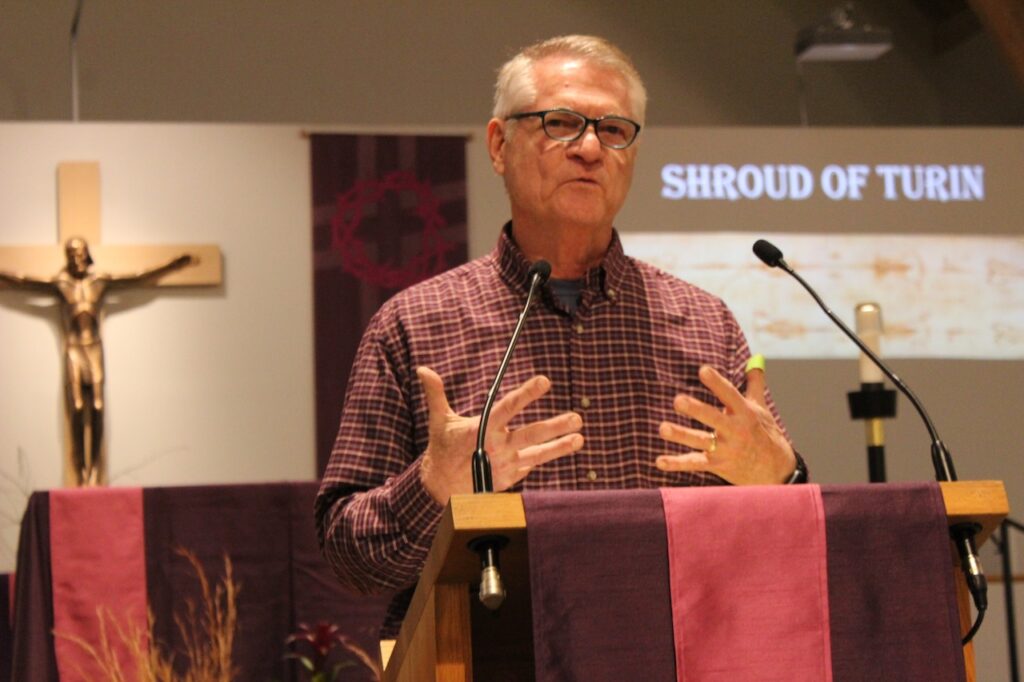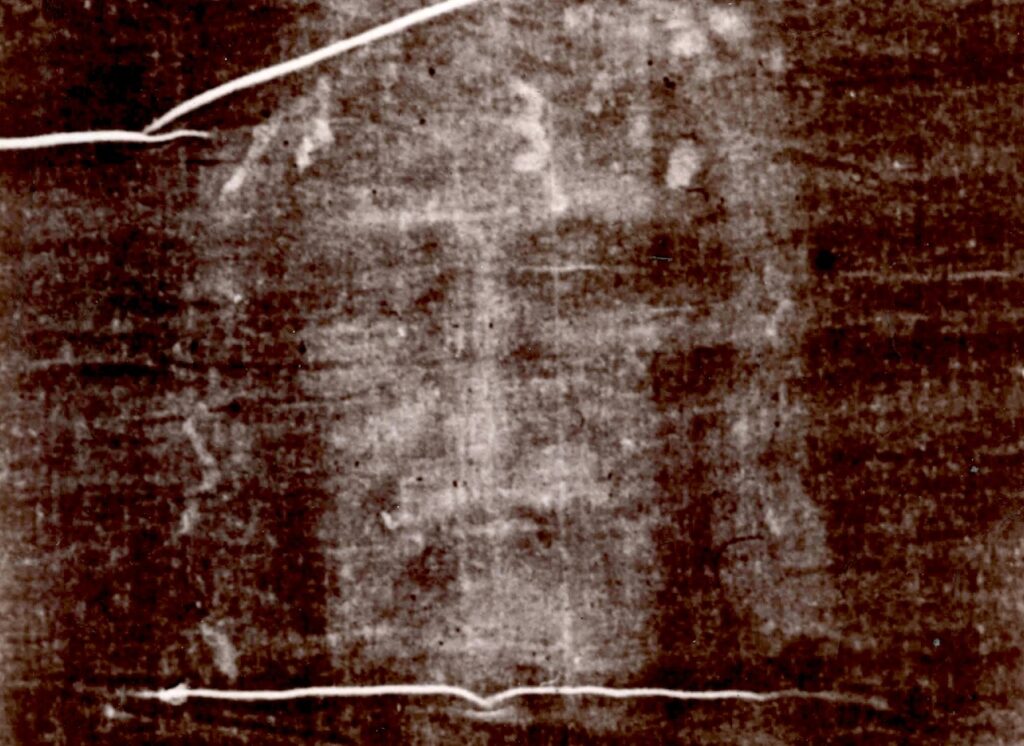St. Leo the Great once said in a sermon that revering the Passion of Christ means “fixing the eyes of our heart on Jesus crucified” and seeing in him our own humanity.
For Mike Pietrzyk of Vinton, the best way to do that has been to study what many believe is the burial cloth that wrapped the tortured body of the Lord after his death on the cross: the Shroud of Turin.
“We can’t say with 100% certainty that the image on the shroud is Jesus because we don’t have DNA of Jesus to compare it to the DNA on the cloth,” said Pietrzyk. “However, from all the scientific clues around the cloth, and scientific questions that have no explanation, hopefully you can draw your own faith conclusion.”

Many years of research have convinced Pietrzyk that the shroud is neither forgery nor religious art. It is a true relic. “For some reason, I believe God gives us a picture of his Son in the 21st century,” he told members of two western Virginia parishes last month. “You are looking at the culmination of his love for you.”
Interest becomes a passion
Raised a Catholic in Michigan, Pietrzyk said he once scoffed when his father told him that the shroud was the burial cloth of Jesus. He went to a Catholic college in Detroit, met his wife, Pamela, and developed a successful career in the restaurant business, running companies that managed franchises such as Little Caesar’s and Firehouse Subs.
Pietrzyk spent a lot of time on the road for business, and in his free time, he was drawn to online articles about the shroud. He learned of a presentation at a church in northern Virginia by an expert and decided to go, leading to even more reading and research.
“For me, as I go through it over and over and over, I have learned a better understanding of what Jesus went through,” Pietrzyk said. He began giving talks, more than two dozen now in three years, with Pamela running the slides for him.
“It was just something that came upon me very strongly and I just ran with,” Pietrzyk said. “I give credit to the Holy Spirit.”
It was a busy Lent for the Pietrzyks, with presentations at parishes in Bedford, Charlottesville, Roanoke and, on a Friday night before St. Patrick’s Day, at St. Thomas More in Lynchburg. About 50 people gathered in the nave to hear Pietrzyk expound on the history, scientific inquiries and imagery of the linen cloth, which measures 14 feet and 3 inches by 3 feet and 7 inches.
Image like no other
From the late afternoon that hands first wrapped the bloody, broken body of Jesus in a burial shroud, its whereabouts in the first millennium are mostly unknown, though records show it was displayed in Jerusalem and Constantinople. It fell into the hands of a French knight in the mid-14th century, when it became an object of veneration, and eventually was acquired by the House of Savoy, a ruling family of Italy. Since 1983, it has belonged to the Holy See.
The scorch marks and water stains on the cloth are damage from a fire in 1532. The hands of Poor Clare nuns patched it in several places and added a cloth backing. In 1898, the shroud was photographed for the first time, starting more than a century of scientific investigation into its authenticity.
Most Catholics are familiar with the black and white photographs, and as Pietrzyk said, have “gazed at the positive image of the man in question from head to toe, looking at the naked body from both sides, face beaten and swollen, puncture wounds across the head, hands nailed, chest cavity run through by a spear, red blood and broken nose.”
The origin of the light brown markings on the cloth that produced those images continue to confound scientists. Pietrzyk pointed out that they show no signs of brush strokes, paint or dye, and that the lines rest on top of the cloth fibers and blood that seeped into them. “This burial cloth with a light brown image on top of the fibers is a photo negative,” Pietrzyk noted.
In this age of digital imagery, a photo negative, or a reverse of a normal image, with light areas dark and dark areas light, seems like ancient technology. But it was unknown in medieval Europe, when skeptics say forgers created the shroud.
A Carbon-14 analysis of a fragment of the shroud in 1988 dated it to the late-13th to mid-14th century. Though the Vatican has never contested the results, controversy has surrounded the tests; the shroud was patched multiple times, and some scientists contend that the carbon samples were contaminated by smoke and bacteria over the years. Other evidence, such as pollen from plants native to the Middle East, suggests the shroud was made well before the Middle Ages.

Contemplating Jesus’ suffering
The Church has never proclaimed that the shroud is an authentic relic, but popes have asked the faithful to use it to think about the suffering that Jesus endured for us. Pope St. John Paul II called the shroud “a mirror of the Gospel”; likewise, Pope Francis prayed before the shroud in 2015 and said that the shroud “draws people to the tormented face and body of Jesus.”
Details of the suffering shown in the images from the shroud had some in the audience shaking their heads.
“Only one person in history that we know got a crown of thorns before being crucified,” Pietrzyk said. “Only one person in history was beaten by Pharisee guards and scourged before being crucified. … For me, I have no doubts the image of the crucified man is Jesus. You have to make your own faith conclusion.”
The doubters this night, if any, were few. “It would take a lot of conspiracy of a lot of people to prove it’s not 2000 years old,” said St. Thomas More parishioner Kevin Parry.
Anthony Cardoza said he wasn’t aware of how severe the scourging was. “That, and how badly beaten his face was and the fact that they actually hammered the thorns into his head,” he said. “You sit there and start thinking about everything he went through.”
The suffering shown in the shroud also touched parishioner Trish Pabis. “You hear of the torture and what Jesus went through,” she said. “But when you see the photos and just hearing the cheek was swollen, the eyelid was ripped. What God did for us! I don’t deserve that, but he did that for us.”
The next public display of the Shroud of Turin is in 2025. Pamela and Mike are planning to be among the millions of pilgrims. They will have about one minute to stand and pray before what they believe in their hearts is the burial cloth of their Savior. It will be the first time in their lives that they are able to fix their eyes on it in person.
Editor’s note: An approved diocesan speaker, Mike Pietrzyk says anyone interested in hosting his presentation can contact him at [email protected].

